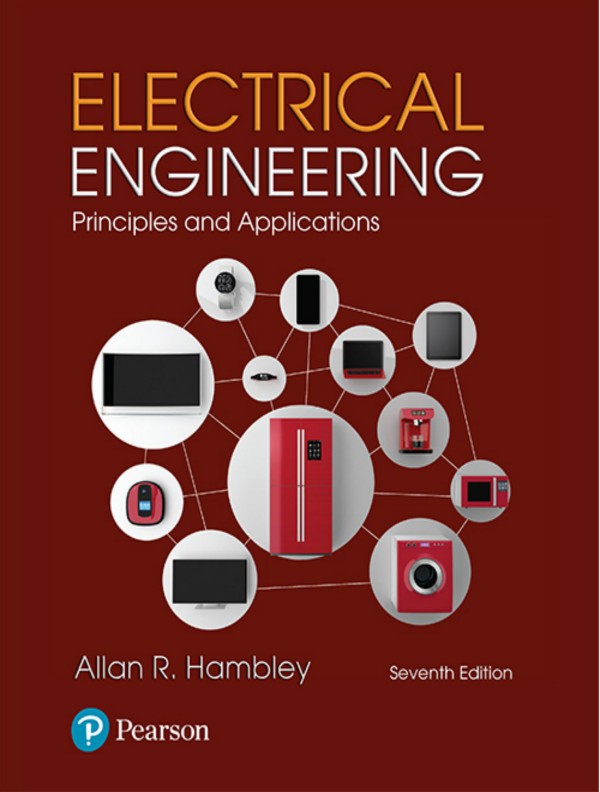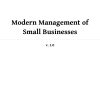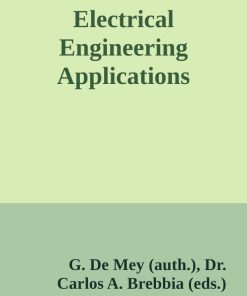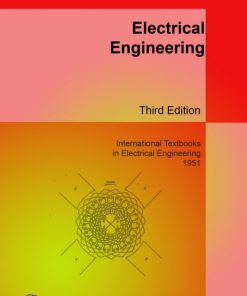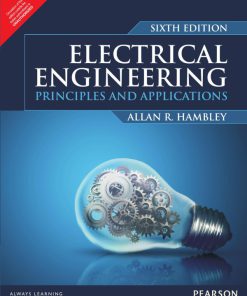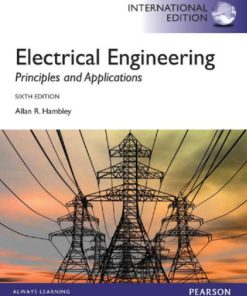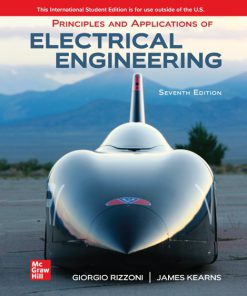(Ebook PDF) Electrical Engineering Principles and Applications 7th Edition by Allan Hambley 0134485335 9780134485331 full chapters
$50.00 Original price was: $50.00.$25.00Current price is: $25.00.
Authors:Allan R Hambley , Series:Electrical Engineering [157] , Author sort:Hambley, Allan R , Languages:Languages:eng , Published:Published:Jan 2018 , Publisher:Pearson
Electrical Engineering: Principles and Applications 7th Edition by Allan R. Hambley – Ebook PDF Instant Download/DeliveryISBN: 0134485335, 9780134485331
Full download Electrical Engineering: Principles and Applications 7th Edition after payment.
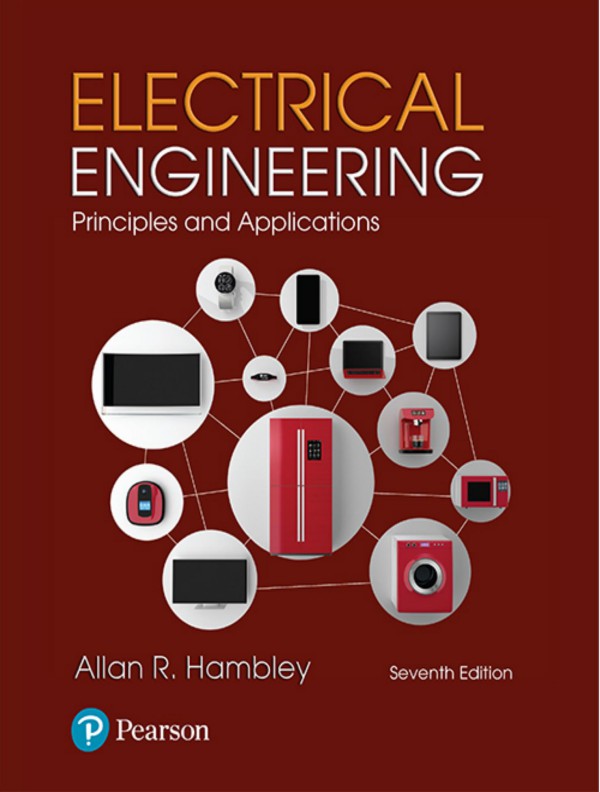
Product details:
ISBN-10 : 0134485335
ISBN-13 : 9780134485331
Author : Allan R. Hambley
For courses in Electrical Engineering. Accessible and applicable learning in electrical engineering for introductory and non-major courses The #1 title in its market, Electrical Engineering: Principles and Applications helps students learn electrical-engineering fundamentals with minimal frustration. Its goals are to present basic concepts in a general setting, to show students how the principles of electrical engineering apply to specific problems in their own fields, and to enhance the overall learning process. This book covers circuit analysis, digital systems, electronics, and electromechanics at a level appropriate for either electrical-engineering students in an introductory course or non-majors in a survey course. A wide variety of pedagogical features stimulate student interest and engender awareness of the material’s relevance to their chosen profession. The only essential prerequisites are basic physics and single-variable calculus. The 7th Edition features technology and content updates throughout the text.
Electrical Engineering: Principles and Applications 7th Table of contents:
Chapter 1 Introduction
Introduction to this chapter:
1.1 Overview of Electrical Engineering
Subdivisions of Electrical Engineering
Why You Need to Study Electrical Engineering
Content of This Book
1.2 Circuits, Currents, and Voltages
Overview of an Electrical Circuit
Fluid-Flow Analogy
Electrical Circuits
Electrical Current
Solution
Reference Directions
Direct Current and Alternating Current
Double-Subscript Notation for Currents
Exercise 1.1
Exercise 1.2
Exercise 1.3
Voltages
Reference Polarities
Double-Subscript Notation for Voltages
Switches
Exercise 1.4
1.3 Power and Energy
Passive Reference Configuration
Solution
Energy Calculations
Solution
Prefixes
Exercise 1.5
Exercise 1.6
1.4 Kirchhoff’s Current Law
Physical Basis for Kirchhoff’s Current Law
Series Circuits
Solution
Exercise 1.7
Exercise 1.8
1.5 Kirchhoff’s Voltage Law
Kirchhoff’s Voltage Law Related to Conservation of Energy
Parallel Circuits
Solution
Exercise 1.9
Exercise 1.10
1.6 Introduction to Circuit Elements
Conductors
Independent Voltage Sources
Ideal Circuit Elements versus Reality
Dependent Voltage Sources
Independent Current Sources
Dependent Current Sources
Resistors and Ohm’s Law
Conductance
Resistors
Resistance Related to Physical Parameters
Solution
Power Calculations for Resistances
Resistors versus Resistances
Solution
Exercise 1.11
Exercise 1.12
Exercise 1.13
1.7 Introduction to Circuits
Using Arbitrary References
Solution
Solution
Exercise 1.14
Exercise 1.15
Summary
Problems
Section 1.1: Overview of Electrical Engineering
Section 1.2: Circuits, Currents, and Voltages
Section 1.3: Power and Energy
Section 1.4: Kirchhoff’s Current Law
Section 1.5: Kirchhoff’s Voltage Law
Section 1.6: Introduction to Circuit Elements
Section 1.7: Introduction to Circuits
Practice Test
Chapter 2 Resistive Circuits
Introduction to this chapter:
2.1 Resistances in Series and Parallel
Series Resistances
Parallel Resistances
Solution
Exercise 2.1
Conductances in Series and Parallel
Series versus Parallel Circuits
2.2 Network Analysis by Using Series and Parallel Equivalents
Circuit Analysis Using Series/Parallel Equivalents
Solution
Power Control by Using Heating Elements in Series or Parallel
Exercise 2.2
2.3 Voltage-Divider and Current-Divider Circuits
Voltage Division
Solution
Current Division
Solution
Solution
Position Transducers Based on the Voltage-Division Principle
Exercise 2.3
Exercise 2.4
2.4 Node-Voltage Analysis
Selecting the Reference Node
Assigning Node Voltages
Finding Element Voltages in Terms of the Node Voltages
Exercise 2.5
Writing KCL Equations in Terms of the Node Voltages
Solution
Exercise 2.6
Circuit Equations in Standard Form
A Shortcut to Writing the Matrix Equations
Exercise 2.7
Solution
Solving the Network Equations
Exercise 2.8
Using MATLAB to Solve Network Equations
Solution
Exercise 2.9
Circuits with Voltage Sources
Solution
Exercise 2.10
Exercise 2.11
Exercise 2.12
Exercise 2.13
Circuits with Controlled Sources
Solution
Solution
Step-by-Step Node-Voltage Analysis
Solution
Exercise 2.14
Exercise 2.15
Using the MATLAB Symbolic Toolbox to Obtain Symbolic Solutions
Checking Answers
Exercise 2.16
2.5 Mesh-Current Analysis
Choosing the Mesh Currents
Exercise 2.17
Writing Equations to Solve for Mesh Currents
Solution
Exercise 2.18
Solving Mesh Equations
Solution
Exercise 2.19
Exercise 2.20
Writing Mesh Equations Directly in Matrix Form
Solution
Exercise 2.21
Mesh Currents in Circuits Containing Current Sources
Exercise 2.22
Exercise 2.23
Circuits with Controlled Sources
Solution
Step-by-Step Mesh-Current Analysis
Solution
Exercise 2.24
Exercise 2.25
2.6 Thévenin and Norton Equivalent Circuits
Thévenin Equivalent Circuits
Solution
Exercise 2.26
Norton Equivalent Circuit
Step-by-Step Thévenin/Norton-Equivalent-Circuit Analysis
Solution
Exercise 2.29
Source Transformations
Solution
Exercise 2.30
Maximum Power Transfer
An All-Too-Common Example.
Solution
Application of Maximum Power Transfer.
2.7 Superposition Principle
Linearity
Using Superposition to Solve Circuits
Solution
Exercise 2.31
Exercise 2.32
2.8 Wheatstone Bridge
Solution
Strain Measurements
Summary
Problems
Section 2.1: Resistances in Series and Parallel
Section 2.2: Network Analysis by Using Series and Parallel Equivalents
Section2.3: Voltage-Divider and Current-Divider Circuits
Section 2.4: Node-Voltage Analysis
Section 2.5: Mesh-Current Analysis
Section 2.6: Thévenin and Norton Equivalent Circuits
Section 2.7: Superposition Principle
Section 2.8: Wheatstone Bridge
Practice Test
Chapter 3 Inductance and Capacitance
Introduction to this chapter:
3.1 Capacitance
Fluid-Flow Analogy
Stored Charge in Terms of Voltage
Current in Terms of Voltage
Solution
Exercise 3.1
Voltage in Terms of Current
Solution
Stored Energy
Solution
Exercise 3.2
3.2 Capacitances in Series and Parallel
Capacitances in Parallel
Capacitances in Series
Solution
Exercise 3.3
Exercise 3.4
3.3 Physical Characteristics of Capacitors
Capacitance of the Parallel-Plate Capacitor
Solution
Exercise 3.5
Practical Capacitors
Electrolytic Capacitors
Parasitic Effects
Solution
3.4 Inductance
Fluid-Flow Analogy
Current in Terms of Voltage
Stored Energy
Solution
Solution
Exercise 3.6
Exercise 3.7
3.5 Inductances in Series and Parallel
Solution
Exercise 3.8
Exercise 3.9
Exercise 3.10
3.6 Practical Inductors
Parasitic Effects for Real Inductors
3.7 Mutual Inductance
Linear Variable Differential Transformer
3.8 Symbolic Integration and Differentiation Using MATLAB
Solution
Exercise 3.11
Summary
Problems
Section 3.1: Capacitance
Section 3.2: Capacitances in Series and Parallel
Section 3.3: Physical Characteristics of Capacitors
Section 3.4: Inductance
Section 3.5: Inductances in Series and Parallel
Section 3.6: Practical Inductors
Section 3.7: Mutual Inductance
Section 3.8: Symbolic Integration and Differentiation Using MATLAB
Practice Test
Chapter 4 Transients
Introduction to this chapter:
4.1 First-Order RC Circuits
Discharge of a Capacitance through a Resistance
Solution
Charging a Capacitance from a DC Source through a Resistance
Solution
Exercise 4.1
Exercise 4.2
4.2 DC Steady State
Solution
Exercise 4.3
4.3 RL Circuits
Solution
Solution
Exercise 4.4
Exercise 4.5
Exercise 4.6
4.4 RC and RL Circuits with General Sources
Solution of the Differential Equation
Step-by-Step Solution
Solution
Exercise 4.7
Exercise 4.8
4.5 Second-Order Circuits
Differential Equation
Mechanical Analog
Solution of the Second-Order Equation
Particular Solution.
Complementary Solution.
Solution
Case I
Case II
Case III
Normalized Step Response of Second-Order Systems
Circuits with Parallel L and C
Exercise 4.9
Exercise 4.10
Exercise 4.11
4.6 Transient Analysis Using the MATLAB Symbolic Toolbox
Solution
Solution
Solving Systems of Linear Differential Equations
Solution
Exercise 4.12
Exercise 4.13
Summary
Problems
Section 4.1: First-Order RC Circuits
Section 4.2: DC Steady State
Section 4.3: RL Circuits
Section 4.4: RC and RL Circuits with General Sources
Section 4.5: Second-Order Circuits
Section 4.6: Transient Analysis Using the MATLAB Symbolic Toolbox
Practice Test
Chapter 5 Steady-State Sinusoidal Analysis
Introduction to this chapter:
5.1 Sinusoidal Currents and Voltages
Root-Mean-Square Values
RMS Value of a Sinusoid
Solution
RMS Values of Nonsinusoidal Voltages or Currents
Solution
Exercise 5.1
Exercise 5.2
Exercise 5.3
5.2 Phasors
Phasor Definition
Adding Sinusoids Using Phasors
Streamlined Procedure for Adding Sinusoids
Solution
Exercise 5.4
Phasors as Rotating Vectors
Phase Relationships
Exercise 5.5
5.3 Complex Impedances
Inductance
Capacitance
Resistance
Complex Impedances in Series and Parallel
Solution
Exercise 5.6
Exercise 5.7
Exercise 5.8
5.4 Circuit Analysis with Phasors and Complex Impedances
Kirchhoff’s Laws in Phasor Form
Circuit Analysis Using Phasors and Impedances
Solution
Solution
Node-Voltage Analysis
Solution
Mesh-Current Analysis
Solution
Exercise 5.9
Exercise 5.10
Exercise 5.11
5.5 Power in AC Circuits
Current, Voltage, and Power for a Resistive Load
Current, Voltage, and Power for an Inductive Load
Current, Voltage, and Power for a Capacitive Load
Importance of Reactive Power
Power Calculations for a General Load
Power Factor
Reactive Power
Apparent Power
Units
Power Triangle
Additional Power Relationships
Complex Power
Solution
Solution
Power-Factor Correction
Solution
Exercise 5.12
Exercise 5.13
5.6 Thévenin and Norton Equivalent Circuits
Thévenin Equivalent Circuits
Norton Equivalent Circuits
Solution
Maximum Average Power Transfer
Solution
Exercise 5.14
Exercise 5.15
5.7 Balanced Three-Phase Circuits
Phase Sequence
Wye–Wye Connection
Power
Reactive Power
Line-to-Line Voltages
Solution
Exercise 5.16
Delta-Connected Sources
Wye- and Delta-Connected Loads
Delta–Delta Connection
Solution
Exercise 5.17
5.8 AC Analysis Using MATLAB
Complex Data in MATLAB
Finding the Polar Form of MATLAB Results
Adding New Functions to MATLAB
Solving Network Equations with MATLAB
Solution
Exercise 5.18
Summary
Problems
Section 5.1: Sinusoidal Currents and Voltages
Section 5.2: Phasors
Section 5.3: Complex Impedances
Section 5.4: Circuit Analysis with Phasors and Complex Impedances
Section 5.5: Power in AC Circuits
Section 5.6: Thévenin and Norton Equivalent Circuits
Section 5.7: Balanced Three-Phase Circuits
Section 5.8: AC Analysis Using MATLAB
Practice Test
Chapter 6 Frequency Response, Bode Plots, and Resonance
Introduction to this chapter:
6.1 Fourier Analysis, Filters, and Transfer Functions
Fourier Analysis
Fourier Series of a Square Wave
Filters
Transfer Functions
Solution
Exercise 6.1
Example: Graphic Equalizer
Input Signals with Multiple Components
Solution
Experimental Determination of the Transfer Function
Exercise 6.2
Exercise 6.3
6.2 First-Order Lowpass Filters
Magnitude and Phase Plots of the Transfer Function
Applying the Transfer Function
Solution
Application of the First-Order Lowpass Filter
Using Phasors with Components of Different Frequencies
Exercise 6.4
Exercise 6.5
6.3 Decibels, the Cascade Connection, and Logarithmic Frequency Scales
Cascaded Two-Port Networks
Logarithmic Frequency Scales
Solution
Exercise 6.6
Exercise 6.7
Exercise 6.8
Exercise 6.9
Exercise 6.10
6.4 Bode Plots
Phase Plot
Exercise 6.11
6.5 First-Order Highpass Filters
Exercise 6.12
Magnitude and Phase of the Transfer Function
Bode Plots for the First-Order Highpass Filte
People also search for Electrical Engineering: Principles and Applications 7th:
electrical engineering principles and applications 7th edition solutions chegg
electrical engineering principles and applications 7th edition chegg
electrical engineering principles and applications 7th global edition
hambley allan r electrical engineering principles and applications 7th edition
hambly allen electrical engineering principles and applications 7th edition

